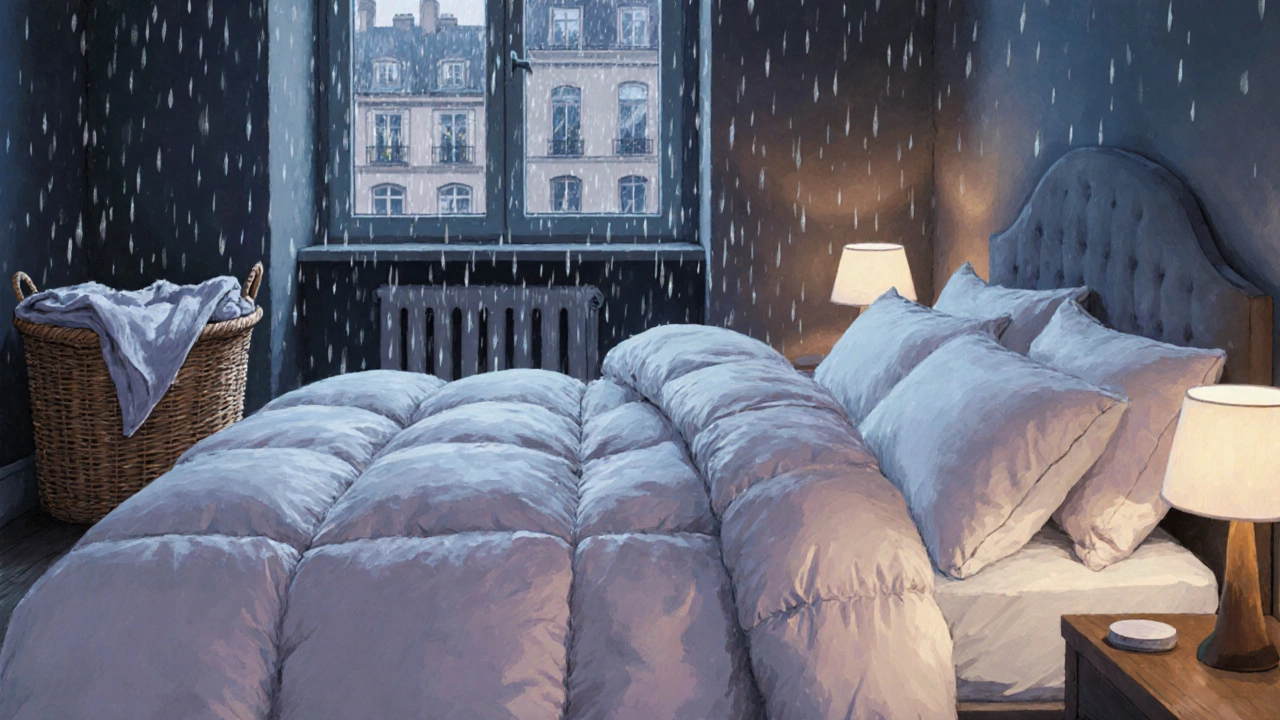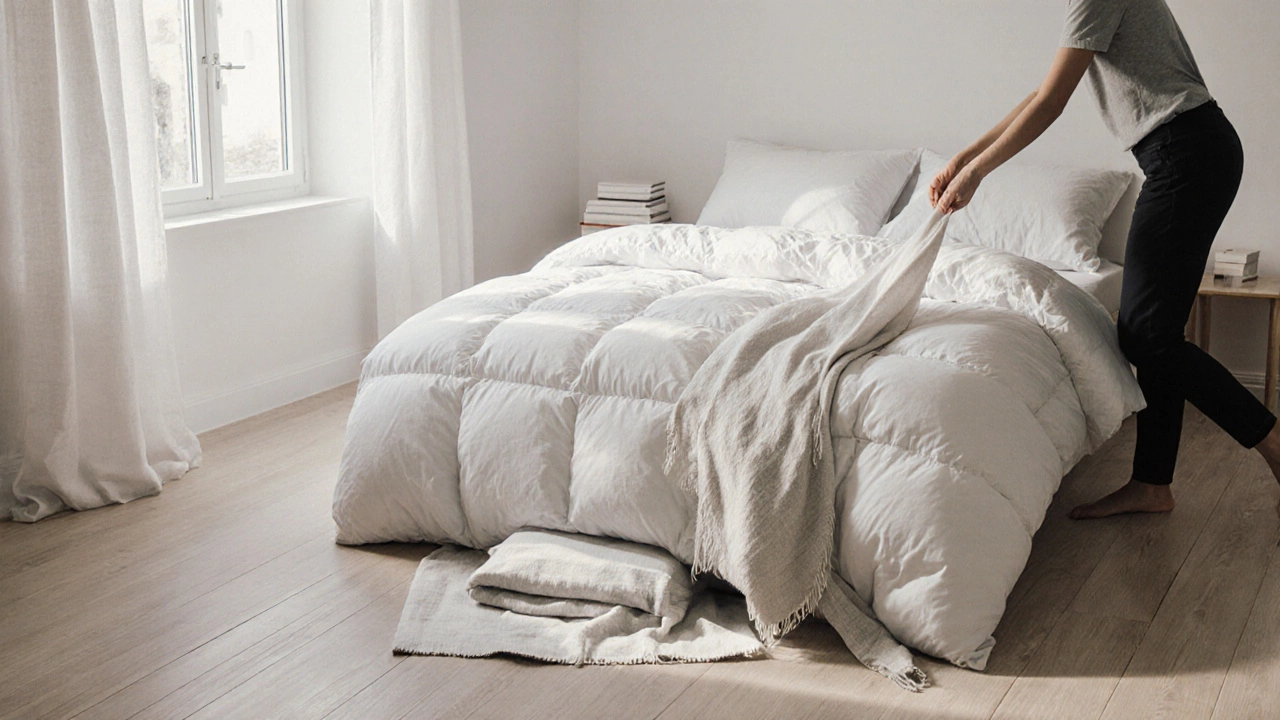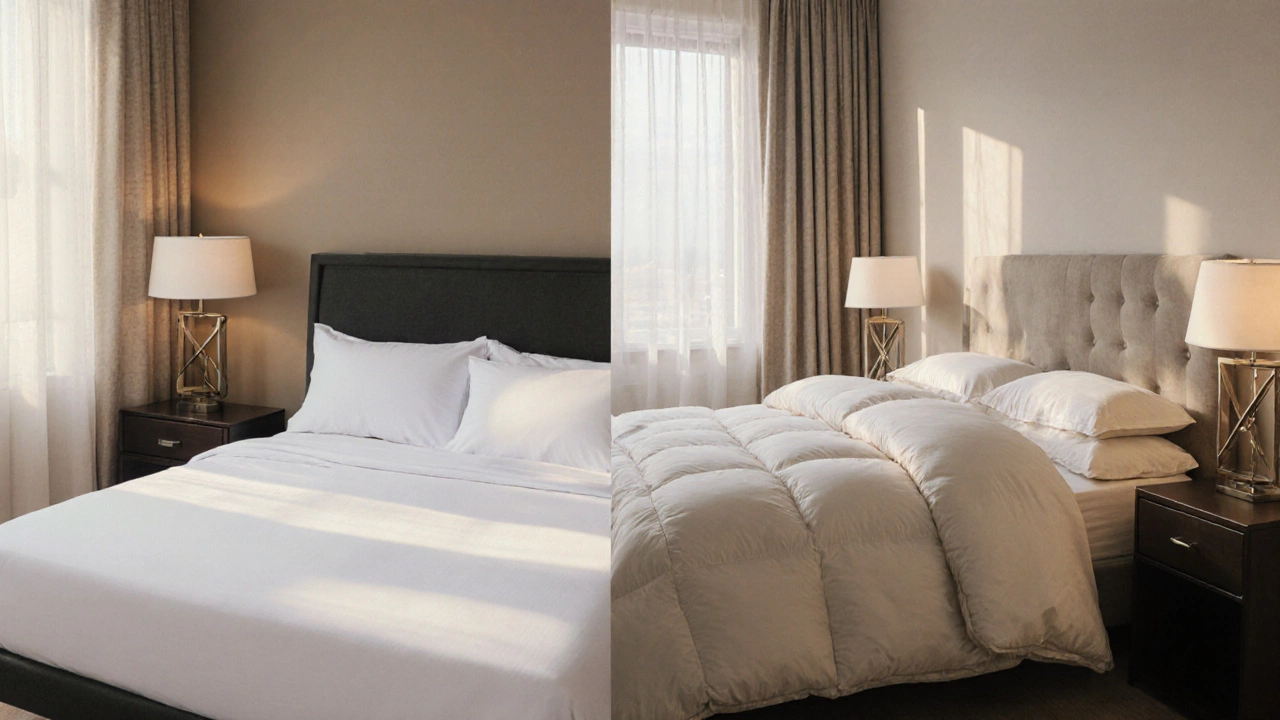Duvet Tog Rating Calculator
European bedding philosophy emphasizes simplicity and breathability. This calculator helps you select the right duvet warmth for your climate based on the principles discussed in the article.
Recommended Tog Rating:
Based on European bedding philosophy, this rating provides optimal comfort and breathability for your conditions.
Why this rating? Europeans typically avoid top sheets, so warmth regulation relies solely on the duvet. This calculation follows European standards where a single-layer duvet system (without a top sheet) requires precise temperature matching.
Ever wondered why your European friends seem to roll straight into a duvet without a top sheet in sight? It’s not a fashion statement or a laziness issue - it’s a mix of climate, comfort philosophy, and historic bedding habits that have shaped the way most of Europe sleeps today.
What the top sheet is a lightweight, flat sheet placed between the sleeper and the blanket or duvet actually is
In North America a typical bed stack looks like this: fitted sheet → top sheet → blanket/comforter. The top sheet acts as a barrier, keeping the blanket clean and adding a thin layer of warmth. It’s usually tucked under the mattress at the foot and sides, then the blanket is layered on top.
How European bedding differs
Most Europeans build their bed around a duvet a soft, insulated blanket filled with down, feathers, or synthetic fibers. The duvet is slipped into a removable duvet cover a washable fabric envelope that protects the duvet, and that’s pretty much it. A fitted sheet goes under the sleeper, but there’s rarely a top sheet involved.
Why the top sheet fell out of favor in Europe
- Climate and insulation. Much of Europe experiences cooler, more humid nights. A thick duvet provides consistent warmth without the need for an extra layer. Adding a top sheet can trap moisture, making the sleeper feel clammy.
- Hygiene simplicity. With a duvet-and-cover system you only wash two pieces - the fitted sheet and the duvet cover - rather than three (fitted sheet, top sheet, blanket). This reduces laundry loads and keeps the duvet cleaner longer.
- Hotel standards. European hotels have long adopted the “duvet only” setup. Travelers get accustomed to it, and the habit follows them home.
- Space efficiency. A top sheet adds bulk when making the bed. In smaller apartments or shared rooms, a sleek duvet‑only look saves space and looks tidier.
- Cultural tradition. The use of a blanket a single-layer covering, often woolen, used before duvets became common dates back centuries. When duvets replaced blankets, the top sheet never really caught on.

Pros and cons of ditching the top sheet
| Aspect | With top sheet | Without top sheet |
|---|---|---|
| Warmth control | Layered warmth; easy to adjust | Single‑layer warmth; relies on duvet rating |
| Linen usage | Three pieces (fitted, top, duvet cover) | Two pieces (fitted, duvet cover) |
| Hygiene | More surfaces to launder | Fewer wash cycles, easier upkeep |
| Moisture management | Can trap sweat between layers | Direct breathability with duvet cover |
| Regional popularity | North America, parts of Asia | Most of Europe, UK, Scandinavia |
What to consider if you still want a top sheet
- Choose the right material. Lightweight cotton or linen works best; heavier flannel can feel redundant under a warm duvet.
- Match the duvet tog. If you have a high‑tog (12+) duvet for winter, a thin top sheet adds little value. Opt for a lower‑tog duvet (7‑10) and let the sheet provide extra warmth.
- Mind the climate. In milder regions (Southern Spain, Mediterranean coasts) a top sheet can be a pleasant cooling layer.
- Keep it tidy. Tuck the sheet loosely if you’re on the go - the goal is comfort, not a perfect hospital‑corner.
- Invest in a quality pillow a cushioned support for the head, typically filled with down, feathers, or synthetic fibers and a good fitted sheet. They’ll make any bedding arrangement feel luxurious.

Quick checklist for a European‑style bed
- Fitted sheet (cotton, percale, or bamboo)
- Duvet with appropriate tog rating for the season
- Duvet cover (washable, preferably 100% cotton)
- Pillow(s) suited to your sleep position
- Optional: a lightweight throw for extra style
Common myths busted
Myth 1: Skipping the top sheet means you’re “cold.”
Reality: A properly insulated duvet keeps you warm enough for most European winters. The key is choosing the right tog rating.
Myth 2: A top sheet protects the duvet better.
Reality: A duvet cover does the job just as well, and it’s easier to remove and wash.
Myth 3: You need a top sheet for an elegant look.
Reality: Minimalist design is hugely popular in Scandinavia and Germany. A well‑made duvet cover can look just as polished.
Frequently Asked Questions
Do Europeans ever use a top sheet?
It’s not unheard of, especially in hotels that cater to international guests, but the majority of households stick to the duvet‑only approach for the reasons listed above.
Can I add a top sheet for summer?
Absolutely. A thin linen sheet can provide a breathable barrier when you swap the heavy duvet for a lightweight blanket or just a cover.
How often should I wash my duvet cover?
Most experts recommend every 2-4 weeks, depending on personal hygiene and whether you have allergies. The fitted sheet can be washed weekly.
Is there a health benefit to dropping the top sheet?
Fewer layers mean less trapped moisture, which can reduce mildew and dust‑mite growth. This can be a plus for allergy sufferers.
What should I look for when buying a duvet?
Check the tog rating (5‑7 for summer, 10‑13 for winter), fill material (down, feather, or high‑quality synthetic), and the thread count of the outer fabric for durability.
Whether you adopt the European minimalist style or stick with a traditional top sheet, the ultimate goal is a good night’s sleep. Understanding the why behind the habit lets you make an informed choice that fits your climate, laundry routine, and personal comfort.
